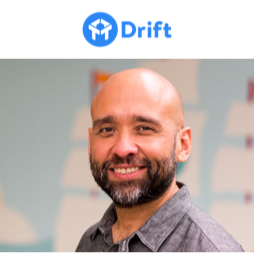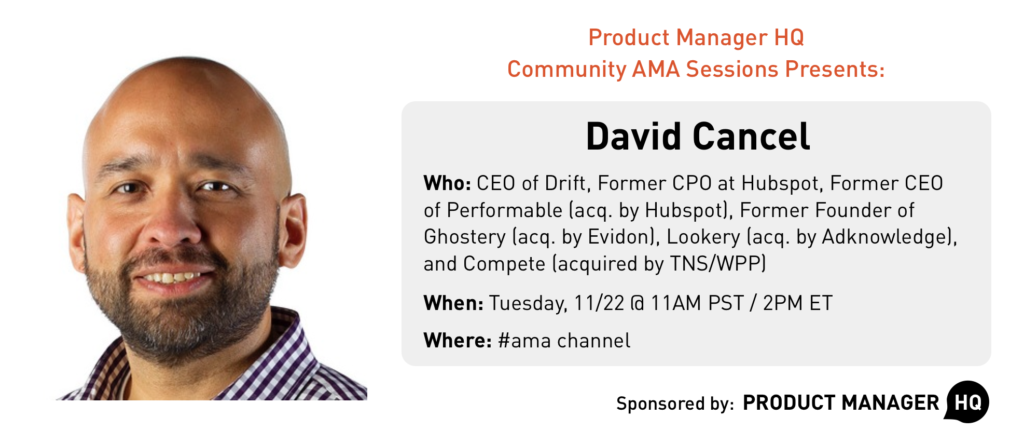David Cancel
About: David Cancel is the founder and CEO of Drift, a messaging app that helps sales and customer success teams connect with their customers. Prior to Drift, David was the Chief Product Officer at HubSpot where he hired most of the HubSpot engineering team — growing from 20 to 100 engineers after HubSpot’s acquisition of David’s last company, Performable. As a five-time founder, there’s been one common thread between all of the products David has built: the connection between businesses and their customers.
He’s also the author of an upcoming book called HYPERGROWTH. In HYPERGROWTH, David will share his modern approach for building products and structuring teams that make customer communication a central priority. HYPERGROWTH tells the story of how Cancel’s customer-driven approach started out as a test with a product team (Performable), transformed an entire organization (HubSpot), and sparked a new movement (Drift).
https://www.drift.com/hypergrowth/
You mentioned you don’t believe in burnouts. Can you elaborate? And talk about how you manage this problem?
Thanks for the question! This is a complicated one. A perfect way to set it off.
I think the term “burnout” is over used. Usually code for “not learning” or “not excited” which are totally different things which have different solutions.
The key is to focus on constant progress in life (the key for me). Focus your time on continuous learning and balance at a “macro” level. Too much time focused on balance at the “micro” level leads to misery IMHO.
I am wondering how important you think design/ux is when a product is starting out? How much of a focus should be put there?
Today design/ux is one of the most important elements in the product, sometimes the most important.
Why? Because we are living in a time of infinite choice in software solutions. This is not Salesforce having the market to themselves for 10 yrs. Now in any category you have 10s, 100s and sometimes 1000s of competitive products. In that world Brand and Design are key differentiators.
What’s your advice on getting first 10 customers with no product and no co-founder?
Simple answer: it’s a numbers game, keep selling, keep pitching, keep taking swings at the bat until you find 10 customers that are “true believers”.
My mantra: If you can find 1 person to buy that means you can find 2. If 2, then 4. if 4 then 8, etc. It’s simple and true.
What would you do if you started Drift in 2016 and wanted to gain traction?
Well I technically started Drift before then but we didn’t come into market until Q2 2016. So I’ll answer the question from that perspective.
What I did was simple but SUPER FREAKING hard to do (for me). I gave the entire company a single Goal (number) to focus on per quarter. Q2 = signups, Q3 = activations and Q4 = monetization.
Curious about how you guys ended up making live chat and what the discovery process was like for you?
Good question. Live chat was/is a commodity (which I like. commodities). We focused on messaging because of
1) The massive shift of consumers (all of us) to default to messaging for most of our conversations in life and realizing that had to make its way back to all business software.
2) We’ve been building sales / marketing software for a very long time and now we saw Marketing Automation, Lead Scoring, etc.. not making sense in this message-first world.
Have you ever walked away from a job/opportunity/problem? If so, how did you decide that walking away/”giving up” (hate that term) was a better solution than keeping at it?
So many times. including selling my own companies to do so.
For me it was always because I felt like I stopped growing/learning. When that happens I need to make a shift. Painful at each of those points but in hindsight always the right call.
Trust your intuition.
What’s your process for going from vision > goals > roadmap > backlog?
It’s changed over time but the most recent thoughts can be found here.
- How to Handle Bugs, Backlog, Prioritization and Communication with the Burndown Framework
- How to Use the Burndown Framework to Build Better Products
- How we Build Products at Drift
As a product guy and entrepreneur… What do you consider your greatest weaknesses and areas of self-doubt? How have you handled or resolved them (both good and bad)?
Sooooooo many. Srsly.
Two biggest areas of weakness: 1. Being a Sales leader (asking for the monies!) and 2. Hiring a Product Executive (because it’s hard to give things over to someone else).
Biggest improvement in both has started with admitting the problem to everyone and trying to get better inch by inch. #noshortcuts
Your space has become quite a bit saturated. How do you stay at the forefront and competitive?
I lean into competition not away from it. Competition means you have a market. Competition means there are customers that care. Love it.
We deal with this by trying to be the closest to the customer. Simple to say and hard to do. We are customer-driven to the core. We are not product-driven, not sales-driven, not marketing-driven, we are customer-driven in everything we do.
I think the next era of successful companies will be those that are closest to the customer.
- Tesla vs Ford
- Airbnb vs Marriott
- Uber vs Yellow cabs/etc.
- Facebook vs AOL
- Amazon vs Walmart
All those on left own the customer relationship.
You are a known critic of agile… do you see value in certifications like Professional Scrum Product Owner… even if for understanding the ideas for processing through what can be received, discarded, and innovated on? I hope that makes sense. What do you think when you see certs like that on a resume?
I am a critic of any methodology or process that is not customer-driven. Whether it’s Agile, JTBD, Waterfall, etc. Whenever we know better than our customers, we lose over the long-term.
We need to get over this idea in product development (technology). It is not the way anything is created in the Lab (science) or in the Studio (arts).
Feedback is oxygen and only customers can give us the right feedback in building for-pay products.
How do you decide when a business is a failure and should no longer be pursued?
Failures are easy. You don’t need a test for failure.
You need a test for “purgatory”. Being ok enough but not great enough to be a success.
The only answer here is to seek feedback and then *listen*. Your gut will tell you long before your brain catches up.
How do you resist the temptation of becoming a settler PM? The temptation to keep on building MVP and saying to yourself i will get to the larger scope in the next iteration
Interesting. Never heard that term.
I’ve been called in “incrementalist” before which I love. Because every increment is done to get feedback from and with our customers.
Have you been in situation where having existing customers who pay for your product are stopping your from innovating or pruning features, because you can disrupt their existing enterprise processes? How would you recommend to handle that?
Hell to the Yes.
It’s not up to them but up to you to keep redefining your ideal persona/customer as you gather more information from the market.
When you continue to do that you might outgrow your current customer base. That doesn’t have to be a bad thing. It might mean you get to serve more of the market which is a great thing.
Any thoughts on how you would get in depth customer feedback from industry leaders etc who are very short on time?
Simple but not easy. You have to solve a problem they *really* care about.
If they have no time for you don’t kid yourself. You are not solving a problem they actually care about.
In dealing with enterprise, are you finding that they’re steering you wrong in anyway? Or, do you find that they’re feedback is the most valuable and always allow it trump anything else?
I don’t take feedback literally. I take it as noise and it’s our job to pattern match.
I wrote this simple framework for organizing feedback – Customer Feedback Framework
Customer-driven doesn’t mean customers will tell you what to build. They can’t. They can only surface problems and your observations can confirm or disconfirm their feedback.
Any good frameworks / books / blog posts for product strategy? have been reading several books and such, but curious to what you have to say?
Top resources: (Seeking Wisdom + Drift blog of course), This is Product Management (Podcast), Growth Everywhere (podcast), Internet History Podcast, Acquired (Podcast), Optimize, Automate, Outsource (podcast)
Can you expand on why it was so hard to set just one goal per quarter?
It’s easy to set one goal per quarter but HARD to maintain that focus because we want to grow in all parts of the business.
It’s hard to ignore monetization while you focus exclusively on Signups lets say. When you want to run fast it’s hard to be patient.
What are some of the common mistakes you see companies make after they have started to get some early adopters who love the product?
Not continuing to perfect their target customer with the data/feedback they are getting from the market.
What specific things should you implement / keep in mind in order to stay closest to your customers? How do you continue to own and maintain the customer relationship over time?
Now you’re talking my religion. Well of course you should use Drift. 🙂
The simplest way to stay customer-focused across your company is to ONLY set customer metrics as goals your team’s own.
Don’t give credit for any metric that isn’t customer-focused.
Bad: Velocity, On time ship dates, Story Points, # of features released, etc.
Good: Uptime, Customer adoption of feature x (by cohort), Customer usage of feature x (by cohort), Customer Churn for customers who use feature x (by cohort), etc.
Join 30,000+ Product People and Get a Free Copy of The PM Handbook and our Weekly Product Reads Newsletter
Subscribe to get:
- A free copy of the PM Handbook (60-page handbook featuring in-depth interviews with product managers at Google, Facebook, Twitter, and more)
- Weekly Product Reads (curated newsletter of weekly top product reads)


